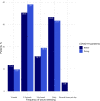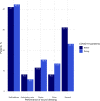Impact of COVID-19 on wound care in Germany
- PMID: 33554436
- PMCID: PMC8014846
- DOI: 10.1111/iwj.13553
Impact of COVID-19 on wound care in Germany
Abstract
Recent studies showed that the COVID-19 pandemic caused collateral damage in health care in terms of reduced hospital submissions or postponed treatment of other acute or chronic ill patients. An anonymous survey was sent out by mail to patients with chronic wounds in order to evaluate the impact of the pandemic on wound care. Sixty-three patients returned the survey. In 14%, diagnostic workup or hospitalisation was cancelled or postponed. Thirty-six percent could not seek consultation by their primary care physician as usual. The use of public transport or long travel time was not related to limited access to medical service (P = .583). In ambulatory care, there was neither a significant difference in the frequency of changing wound dressings (P = .67), nor in the person, who performed wound care (P = .39). There were no significant changes in wound-specific quality of life (P = .505). No patient used telemedicine in order to avoid face-to-face contact or anticipate to pandemic-related restrictions. The COVID-19 pandemic impaired access to clinical management of chronic wounds in Germany. It had no significant impact on ambulatory care or wound-related quality of life. Telemedicine still plays a negligible role in wound care.
Keywords: COVID-19; leg ulcer; quality of life; telemedicine; wounds.
© 2021 The Authors. International Wound Journal published by Medicalhelplines.com Inc (3M) and John Wiley & Sons Ltd.
Conflict of interest statement
The authors declared no potential conflicts of interest.
Figures



References
-
- Negrini S, Grabljevec K, Boldrini P, et al. Up to 2.2 million people experiencing disability suffer collateral damage each day of COVID‐19 lockdown in Europe. Eur J Phys Rehabil Med. 2020;56(3):361‐365. - PubMed
MeSH terms
Grants and funding
LinkOut - more resources
Full Text Sources
Other Literature Sources
Medical

